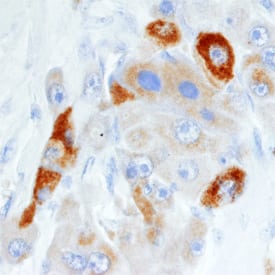Human pIgR Antibody
R&D Systems, part of Bio-Techne | Catalog # MAB27171

Key Product Details
Species Reactivity
Validated:
Cited:
Applications
Validated:
Cited:
Label
Antibody Source
Product Specifications
Immunogen
Lys19-Arg638
Accession # P01833
Specificity
Clonality
Host
Isotype
Scientific Data Images for Human pIgR Antibody
pIgR in Human Liver Cancer Tissue.
pIgR was detected in formalin fixed paraffin-embedded sections of human liver cancer tissue using Mouse Anti-Human pIgR Monoclonal Antibody (Catalog # MAB27171) at 15 µg/mL overnight at 4 °C. Tissue was stained using the Anti-Mouse HRP-DAB Cell & Tissue Staining Kit (brown; Catalog # CTS002) and counterstained with hematoxylin (blue). Specific staining was localized in the cytoplasm. View our protocol for Chromogenic IHC Staining of Paraffin-embedded Tissue Sections.Applications for Human pIgR Antibody
Immunohistochemistry
Sample: Formalin fixed paraffin-embedded sections of human liver cancer tissue
Reviewed Applications
Read 1 review rated 5 using MAB27171 in the following applications:
Formulation, Preparation, and Storage
Purification
Reconstitution
Formulation
Shipping
Stability & Storage
- 12 months from date of receipt, -20 to -70 °C as supplied.
- 1 month, 2 to 8 °C under sterile conditions after reconstitution.
- 6 months, -20 to -70 °C under sterile conditions after reconstitution.
Background: pIgR
The human polymeric immunoglobulin receptor (pIgR; also known as membrane secretory component) is a 100 kDa type I transmembrane glycoprotein that is synthesized as a 764 amino acid (aa) precursor. It includes a signal sequence (aa 1-18), an extracellular region (aa 19-638), a transmembrane segment (aa 639-661), and a cytoplasmic domain (aa 662-764) (1-3). The extracellular region consists of five Ig-like domains and a sixth non-Ig domain that connects to the membrane region. pIgR is expressed on secretory epithelial cells of exocrine tissues. Immunoglobulin isotypes consist of two heavy (H) and two light (L) chains. For IgA and IgM, this H2L2 monomer can form larger polymers through association with a joining chain (J chain). The Fc regions of IgA and IgM have a carboxy-terminal extension called a secretory tailpiece that binds the J chain (4). pIgR functions as a carrier that transports IgA and IgM across epithelium (5). On the basolateral surface of epithelial cells, the receptor initially binds non-covalently to IgA via a docking site on the J chain. This initiates a rearrangement in which a disulfide bond forms between pIgR and an IgA heavy chain (2). The complexes are then internalized and transcytosed to the apical surface. A soluble covalent complex called secretory IgA (SIgA) is now generated by proteolytic cleavage of the sixth extracellular domain of pIgR and released into the lumen (6). This IgA-bound and proteolytically generated pIgR fragment is referred to as secretory component (SC). Notably, human pIgR transcytoses constitutively, with or without ligand, creating both bound and free, 78 kDa SC following cleavage (3). The extracellular region of pIgR is 64%, 65%, and 70% aa identical to the equivalent region in rat, mouse and porcine, respectively. The receptor component of the complex anchors the SIgA molecule to mucous (7). SIgA is a crucial component of the mucosal immune system serving to protect the large expanse of mucous membranes that form a barrier between the interior of the body and the external environment (8).
References
- Krajci, P. et al. (1989) Biochem. Biophys. Res. Commun. 158:783.
- Piskurich, J. et al. (1995) J. Immunol. 154:1735.
- Brandtzaeg, P. and F-E. Johansen (2001) Trends Immunol. 22:545.
- Braathen, R. et al. (2002) J. Biol. Chem. 277:42755.
- Ben-Hur, H. et al. (2004) Int. J. Mol. Med. 14:35.
- Asano, M. et al. (2004) Immunology 112:583.
- Phalipon, A. and B. Corthesy (2003) Trends Immunol. 24:55.
- Uren, T. et al. (2003) J. Immunol. 170:2531.
Long Name
Alternate Names
Gene Symbol
UniProt
Additional pIgR Products
Product Documents for Human pIgR Antibody
Product Specific Notices for Human pIgR Antibody
For research use only
